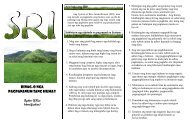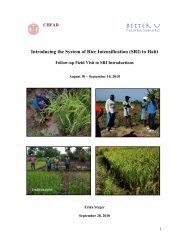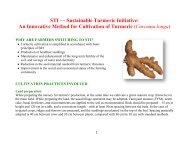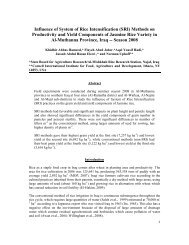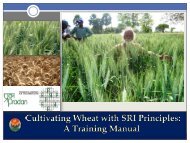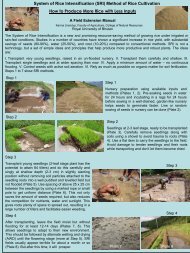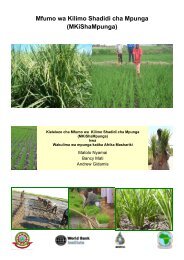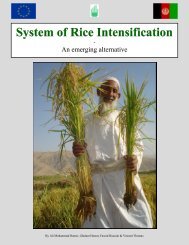EFFECT OF THE SYSTEM OF RICE INTENSIFICATION (SRI) ON ...
EFFECT OF THE SYSTEM OF RICE INTENSIFICATION (SRI) ON ...
EFFECT OF THE SYSTEM OF RICE INTENSIFICATION (SRI) ON ...
You also want an ePaper? Increase the reach of your titles
YUMPU automatically turns print PDFs into web optimized ePapers that Google loves.
forced to sell labour in order to survive at this time of year. Husain et al. (2004) concluded from<br />
trials with <strong>SRI</strong> in Bangladesh that only large farmers could increase their production of <strong>SRI</strong> without<br />
any risks as they are not as vulnerable to changes and difficulties as small scale farmers. Larger<br />
farmers would in this case be identified as farmers with higher incomes.<br />
Richer farmers will in general have more time as they do not only rely on income from rice as<br />
illustrated in figure 9. Farmers with lower incomes will have to use large percentages of their<br />
available time on selling labour far away from their homestead thus having less time available to<br />
take care of their rice fields. In terms of compost production larger farmers would most likely also<br />
be able to produce larger amounts due more domestic animals.<br />
All in all the target farmers seem to have adopted <strong>SRI</strong> now, at least for the moment. Before the<br />
initiation of the project 50% of the households experienced some degrees of conflicts but after some<br />
time the <strong>SRI</strong> fields showed strong growth and the conflicting counterparts in the households are<br />
now satisfied and believes in <strong>SRI</strong>. Such scepticism is most likely found in many implementing<br />
projects in the beginning. Presumably it relates to the type of paradigm used out of the three<br />
described by Blaikie et al. (1997): Classic, Neo-Liberal and Neo populist.<br />
Another sign of the success of <strong>SRI</strong> so far in the area is that farmers have spread the knowledge of<br />
<strong>SRI</strong> to their neighbours, approximately 10 persons (+ -9) who did not attend any training with<br />
CEDAC. Again it is a very high number and the fact that the author and CEDAC staff interviewed<br />
the farmers might have affected them to respond in a more positive way than reality. The effect is<br />
however very interesting. It is a so called “roll on” effect where practising <strong>SRI</strong> farmers will share<br />
their techniques with other interested farmers (Kabir, 2006) and again these farmers will inspire<br />
others to adopt <strong>SRI</strong>. The success of such a roll on effect will depend on the way a given system (in<br />
this case <strong>SRI</strong>) has been introduced to the community – which is a different way of sharing<br />
knowledge often practised by organizations introducing and bringing an idea to farmers (Kabir,<br />
2006). CEDAC has introduced <strong>SRI</strong> to the farmers through <strong>SRI</strong> experiments, campaigns and leaflets<br />
amongst others. Thus the interpretation is rather open and hence farmers will perform <strong>SRI</strong> as they<br />
think it should be which by involving them in such a way must be considered more sustainable.<br />
59



